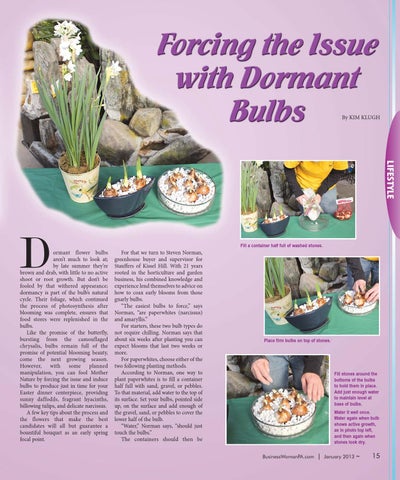By KIM KLUGH
LIFESTYLE
D
ormant flower bulbs aren’t much to look at; by late summer they’re brown and drab, with little to no active shoot or root growth. But don’t be fooled by that withered appearance; dormancy is part of the bulb’s natural cycle. Their foliage, which continued the process of photosynthesis after blooming was complete, ensures that food stores were replenished in the bulbs. Like the promise of the butterfly, bursting from the camouflaged chrysalis, bulbs remain full of the promise of potential blooming beauty, come the next growing season. However, with some planned manipulation, you can fool Mother Nature by forcing the issue and induce bulbs to produce just in time for your Easter dinner centerpiece, providing sunny daffodils, fragrant hyacinths, billowing tulips, and delicate narcissus. A few key tips about the process and the flowers that make the best candidates will all but guarantee a bountiful bouquet as an early spring focal point.
Fill a container half full of washed stones.
For that we turn to Steven Norman, greenhouse buyer and supervisor for Stauffers of Kissel Hill. With 21 years rooted in the horticulture and garden business, his combined knowledge and experience lend themselves to advice on how to coax early blooms from those gnarly bulbs. “The easiest bulbs to force,” says Norman, “are paperwhites (narcissus) and amaryllis.” For starters, these two bulb types do not require chilling. Norman says that about six weeks after planting you can expect blooms that last two weeks or more. For paperwhites, choose either of the two following planting methods. According to Norman, one way to plant paperwhites is to fill a container half full with sand, gravel, or pebbles. To that material, add water to the top of its surface. Set your bulbs, pointed side up, on the surface and add enough of the gravel, sand, or pebbles to cover the lower half of the bulb. “Water,” Norman says, “should just touch the bulbs.” The containers should then be
Place firm bulbs on top of stones.
Fill stones around the bottoms of the bulbs to hold them in place. Add just enough water to maintain level at base of bulbs. Water it well once. Water again when bulb shows active growth, as in photo top left, and then again when stones look dry. BusinessWomanPA.com
|
January 2013
~
15
